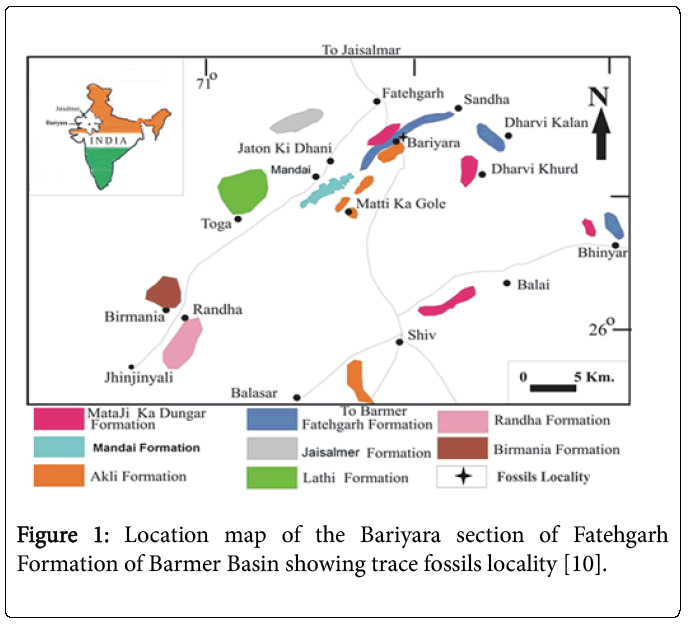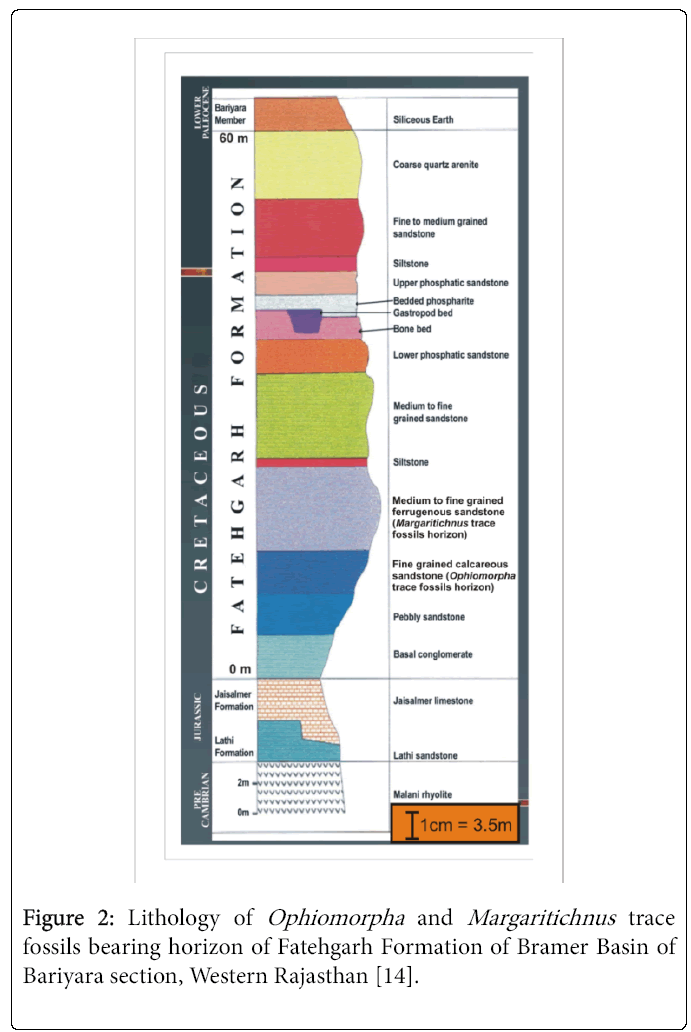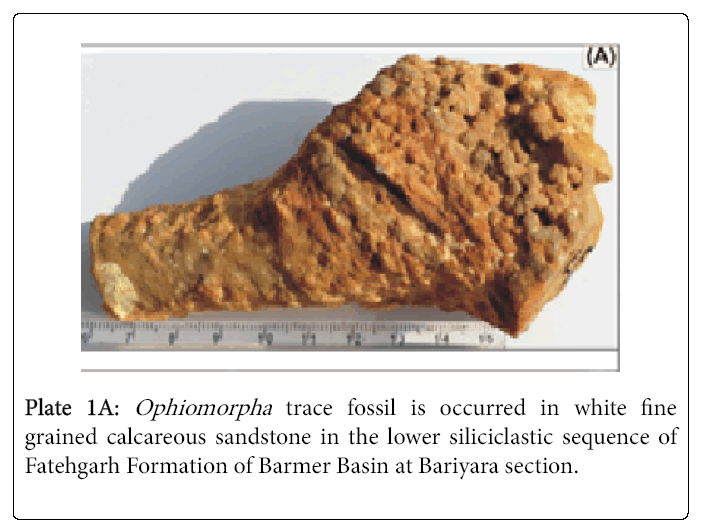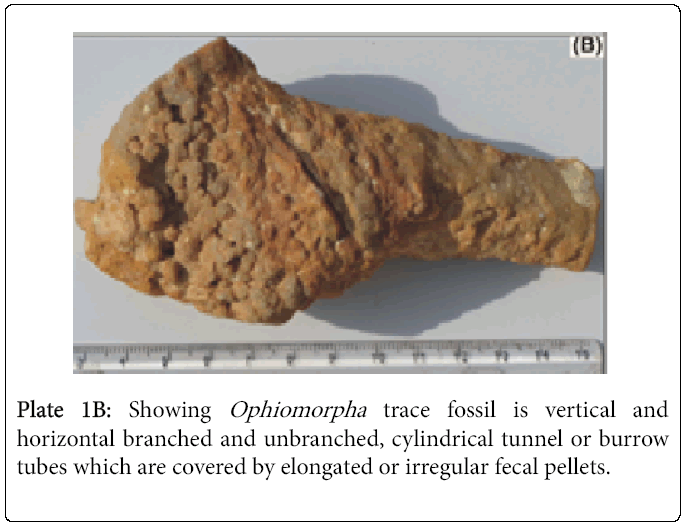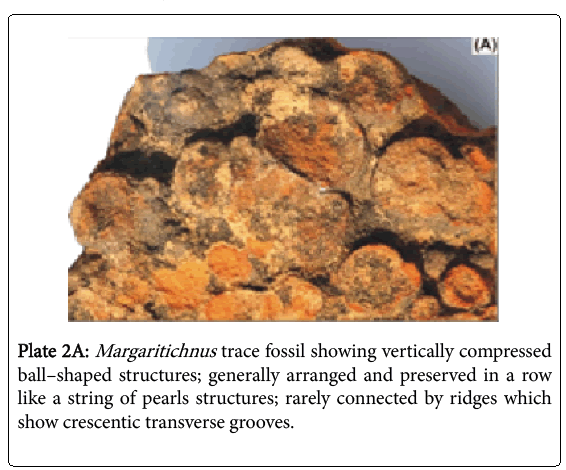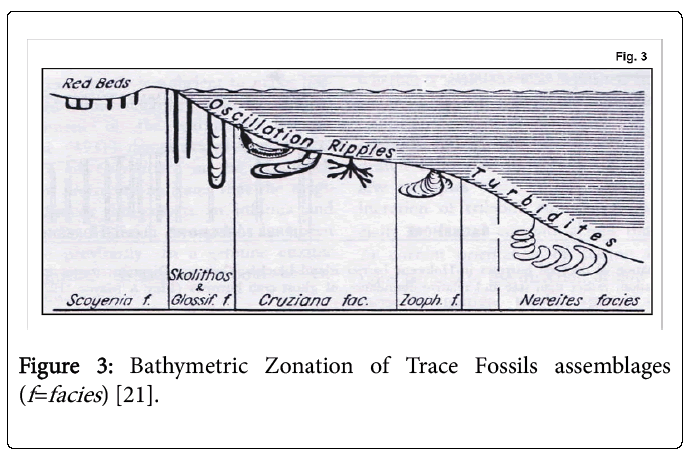Review Article Open Access
Near Shore -Shallow Marine (Ophiomorpha and Margaritichnus) Trace Fossils from Fatehgarh Formation of Barmer Basin, Western Rajasthan, India
Parihar VS*, Nama SL, Khichi CP, Shekhawat NS, Snehlata M and Mathur SC
Department of Geology, Jai Narain Vyas University, Jodhpur, Rajasthan, India
- *Corresponding Author:
- Parihar VS
Department of Geology
Jai Narain Vyas University
Jodhpur - 342005, Rajasthan, India
Tel: +90374 254 2665
Fax: +91-9929217873
E-mail: geoparihar@gmail.com
Received date: January 09, 2016 Accepted date: March 23, 2016 Published date: March 30, 2016
Citation:Parihar VS, Nama SL, Khichi CP, Shekhawat NS, Snehlata M, et al. (2016) Near Shore - Shallow Marine (Ophiomorpha and Margaritichnus) Trace Fossils from Fatehgarh Formation of Barmer Basin, Western Rajasthan, India. J Ecosys Ecograph 6: 180. doi:10.4172/2157-7625.1000180
Copyright: © 2016 Parihar VS, et al. This is an open-access article distributed under the terms of the Creative Commons Attribution License, which permits unrestricted use, distribution, and reproduction in any medium, provided the original author and source are credited.
Visit for more related articles at Journal of Ecosystem & Ecography
Abstract
Two trace fossils namely Ophiomorpha and Margaritichnus have been reported from the Bariyara section of the Fatehgarh Formation of Barmer Basin. Here the Margaritichnus trace fossil sp. is the first record from the western Rajasthan. The present study area is located about 6 km south of Fatehgarh town and 70 kms north of Barmer on Bramer–Jaisalmer road. The Ophiomorpha trace fossils are found in white fine grained calcareous sandstone from lower siliciclastic sequence while Margaritichnus trace fossils occurs in dark brown medium to fine grained ferruginous sandstone of middle phosphorite - siliciclastic sequence of the Fatehgarh Formation of Barmer Basin. The Ophiomorpha trace fossils were considered as crustaceans and shrimps whereas Margaritichnus were mainly produced by worm–like deposits feeders such as sipunculids and priapulids or possibly hydrozoa. The ichnological and sedimentological investigations suggests near - coastal shallow marine depositional environment for the Fatehgarh Formation of the Barmer Basin. It is difficult to attribute a more specific age of Bariyara section of Fatehgarh Formation because of the long stratigraphic range of Margaritichnus (Permian-Cretaceous) and Ophiomorpha (Permian-Recent) as attributed the Fatehgarh Formation to the Cretaceous age on the basis of microvertebrate assemblages recorded from the same Bariyara section.
Keywords
Near-shore; Shallow marine; Ophiomorpha; Margaritichnus ; Trace fossils; Fatehgarh formation; Barmer basin; Western Rajasthan
Introduction
Barmer Basin is the Mesozoic–Tertiary basin extends for about 100 kms in north-south direction and 50 kms in east-west as its maximum width [1]. It is tectonically a graben bounded in north by Fatehgarh fault, in east by Sarnu fault and in west by Barmer Faults [2]. The horst is in its eastern flanks is made up of Jodhpur sector of Malani Igneous Suite and its north -western flanks is made up of Devikote High [3]. Datta [4], Biswas [5], Biswas et al. [6] opined that Barmer Basin considered as northern extension of Cambay Basin and southern extension of main Indus Basin. The rocks of the Barmer Basin are grouped into seven namely, Sarnu Formation, Fatehgarh formatiom, Barmer Hill Formation, Akli Formation, Mataji ka Dungar Formation, Kapurdi Formation and Uttarlai Formation. The Sarnu Formation consists of siliciclastic facies with plant fossils of Early Cretaceous age, the Fatehgarh Formation is represented by siliciclastic and phosphorite rocks having significant microvertebrates - magnetic spherule bearing bone bed and gastropod bed of Late Cretaceous age [1,7] the Barmer Hill Formation consists of siliciclastic rocks with poorly preserved plant fossils and well -preserved Asthenopodichium wood bearing trace fossils of Palaeocene age [1], the Akli Formation is consists of bentonite, clay, lignite and siliciclastic rocks with gastropods, microvertebrates and plant fossils of Palaeocene to Early Eocene age [8], the Mataji ka Dungar Formation is represented by clay and bentonitic clay at the base and fining upward sequences of siliciclastic rocks of Middle to Late Palaeocene age [9,10]. The Kapurdi Formation is consists of fuller’s Earth, gypseous clay, bioclastic limestone and marl with plants fossils, crabs, shrimps, turtles, fishes and gastropods of Early Eocene age [11]. The Uttarlai Formation is represented by salt, gypsum, gypseous clay and sands of Quaternary age [12]. The Barmer Basin is floored by Malani igneous suite, Lathi sandstone and Jaisalmer Formation [3].
The rocks of the Barmer Basin studied for ichnological aspects by various workers and many trace fossils are already recorded such as Borkar and Kulkarni [13] reported Thalassinoides , Planolites and Planolites Montanus from Fatehgarh Formation; Ophiomorphaand Margaritichnus trace fossils from Fatehgarh Formation reported by Parihar et al. [14] and Parihar and Mathur [15] recorded Thalassinoides , Ophiomorpha , Burrow Tubes, Halymenidium and Rhizocorallium trace fossils from Mandai Formation.
The present investigation here deals with detailed study of Ophiomorpha and Margaritichnus from Fatehgarh Formation of Barmer Basin at Bariyara area. The Ophiomorpha trace fossils are found in fine grained calcareous sandstone in the lower siliciclastic sequence whereas Margaritichnus trace fossils are found in medium to fine grained ferruginous sandstone of middle phosphorite-siliciclastic sequence of Fatehgarh Formation at Bariyara section. The present paper embodies the systematic ichnology of trace fossils found in Bariyara section of Fatehgarh Formation to establish the depositional conditions and environment of deposition of trace fossils bearing facies of the area.
Geology of the Study Area
The outcrops of the Fatehgarh Formation are dominantly formed the northern fringe of the Barmer Basin. In the study area, they form low lying continuous ridges running from Kodiasar to Bariyara in west and upto Sandha in the east through Bakra Kudan and Jogmaya temple. Sometimes they form very bold and high hillocks. The overall strike length of ridges, running from Jaton ki Dhani through Bariyara to Sandha is about 15 kms in the northern periphery of the Barmer Basin. All along this ridge, it has been observed that the basal conglomerate and pebbly sandstone of Fatehgarh Formation unconformably overlies the Lathi sandstone (Early Jurassic) in north eastern and Jaisalmer limestone (Middle to Late Jurassic) in north western periphery of the basin. The top lithounit quartz arenite of Fatehgarh Formation is unconformably overlain by the siliceous earth of basal Bariyara member of the Akli Formation of Palaeocene to Early Eocene age. The contact can be seen at Lordi Nala section near Bariyara village, Bakra Kudan, and near Kodiasar. The overall thickness of Fatehgarh Formation is reported to be of 520 m [12]. The contacts between Bariyara member of Akli Formation is marked by a paleosole of laterite soil and sandstone of Mataji ka Dungar Formation and can be seen at the base of Mataji ka Dungar. There are some Nala sections, fault scrap, land incision and quarry sections, which provide ample opportunities to study the vertical and lateral relationship among the lithofacies of the study area [16,17]. The present study area is located about 70 kms north of Barmer on Barmer – Jaisalmer NH-65 (Figure 1). The lithology of the Fatehgarh Formation of the Barmer Basin are classify into three lithofacies viz., lower siliciclastic fining upward sedimentary sequence; middle phosphorite lithofacies sequence and upper a coarsening upward sliciclastic sequence [3] (Table 1). Here the Ophiomorpha trace fossils are occurred in fine grained calcareous sandstone in the lower siliciclastic sequence whereas Margaritichnus trace fossils are found in medium to fine grained ferruginous sandstone of middle phosphorite - siliciclastic sequence of Fatehgarh Formation at Bariyara section (Figure 2).
| Lower Palaeocene | AkliFormation | Bariyara member | Siliceous earth |
|---|---|---|---|
| ----------------------------------------------Unconformity ----------------------------------------------- | |||
| Cretaceous | Fatehgarh Formation | Upper coarsening upwardLithofaciesassociation | Quartz arenite |
| Fine to medium grained sandstone | |||
| Silstone | |||
| MiddlePhosphoriteLithofacies Association | Medium grained upper phosphatic sandstone | ||
| Upper gastropod bed | |||
| Bedded phosphorite | |||
| Lower gastropod bed | |||
| Bone bed | |||
| Medium grained lower phosphatic sandstone | |||
| Fine to medium grained sandstone- claystone | |||
| Lower Siliciclastic Fining upwardLithofaciesAssociation | Siltstone | ||
| Fine grainedcalcareous sandstone | |||
| Coarseto medium grained sandstone | |||
| Pebbly Sandstone | |||
| Conglomerate | |||
| -------------------------------------------------Unconformity----------------------------------------------- | |||
| Upper Jurassic | JaisalmerFormation | Limestone | |
| Lower –Middle Jurassic | LathiFormation | Sandstone | |
Table 1: The lithology of the Fatehgarh Formation of the Barmer Basin [1,3].
Trace Fossils
The present paper here deals with two trace fossils from the white fine grained calcareous sandstone and dark brown medium to fine grained ferruginous sandstone of Fatehgarh Formation of Barmer Basin in Bariyara area. They are identified as Ophiomorpha and Margaritichnus trace fossils and both ichnospecies are well -preserved and abundant nature in Fatehgarh Formation of Barmer Basin in Bariyara area.
Systematic Ichnology
The present study of ichnology follows the Treatise on invertebrate Palaeontology [18]. The morphological classification of Simpson [19], ethological classification of Seilacher [20] and facies classification of Seilacher [20,21] are adopted.
Ichnogenus: Ophiomorpha (Lundgren), (Plate 1A and 1B)
Material: DG/JNVU/FGF/TF/01
Description: Vertical and horizontal branched and unbranched, cylindrical tunnel or burrow systems, having diameter of burrow tube is about 2.5 cm and length is about 11-12 cm. The interior walls of burrow tubes are smooth whereas the burrow tubes are covered by elongated or irregular fecal pellets. The burrow tubes were filled with surrounding calcareous sediments.
Remarks: Ophimorpha is feeding and dwelling burrow which normally occur in shallow water near-shore deposits [22,23], but also has been reported from deep-sea deposits [24-30], since the Mesozio [31]. It is mainly produced by crustaceans, shrimps and ghost shrimps where as it is also formed by shrimps comparable to recent callianassids in the Mesozoic - Cenozoic sediments [22,23].
Occurrence: White fine grained calcareous sandstone of Fatehgarh Formation of Barmer Basin, Bariyara area, Barmer, Western Rajasthan.
Ichnogenus: Margaritichnus (Bandel) (Plate 2A and 2B)
Material: DG/JNVU/FGF/TF/02
Description: Vertically compressed ball – shaped structures; generally arranged and preserved in a row like a string of pearls structures; rarely connected by ridges which show crescentic transverse grooves. The diameter of each ball structure is about 12 mm – 30 mm and the forming string of pearls structures is about 9 cm –13 cm.
Remarks: Balls are considered as fecal pellets probably produced by large worm like sediment eating animals such as Sipunculids, Priapulids or possibly Hydrozoa. The trail possibly formed below the surface of the sediment [18].
Occurrence: Dark brown medium to fine grained ferruginous sandstone of Fatehgarh Formation of Barmer Basin, Bariyara area, Barmer, Western Rajasthan.
Palaeoenvironmental Significance of Trace Fossils
Trace fossils are biogenic structures preserved on or within the sediments by an organism during their various movements such as dwelling, feeding, resting etc. They are widely used for the interpretation of the palaeoenvironment of the sediments/rocks. Accordingly Hantzshel [18], Seilacher [20,21], Frey and Howard [23], Simpson [19], trace fossils have palaeoenvironmental significance. The sediments of Fatehgarh Formation are examined for ichnological investigation and their role during the deposition of those sediments. Here Ophiomorpha and Margaritichnus trace fossils have been recorded, analyzed, described and used for palaeoenvironment interpretation. Palaeoenvironment of marine sediments can be interpreted by investigating lithology, primary sedimentary structures, and faunal elements, but recently trace fossils and association of trace fossils due to their autochthonous nature; they have been proved very helpful in palaeogeographic investigations [18]. Seilacher [32], has proved that the typical trace fossil assemblages occur in different location in sediments of different ages. Such assemblage belongs to a particular marine environment and is composed of typical association of trace fossils, constituting ichnofacies [18]. Seilacher [21] has introduced the ichnofacies classification and he has grouped all known trace fossils into six ichnofacies namely, Scoyenia Facies (non-marine commonly red beds), Skolithoes Facies (littoral; rapid sedimentation), Glossifungites Facies (littoral; with erosional surface), Cruziana Facies (deeper shallow water, below the true littoral zone), Zoophycus Facies (transitional to bathyal zone) and Nereites Facies (bathyal to abyssal; pelagic sediments and turbidites) (Figure 3). Both (Ophiomorpha and Margaritichnus ) trace fossils are belongs to Skolithos Facies which indicate that sediments of the Fatehgarh Formation of Barmer Basin of Bariyara area was deposited in littoral to sub-littoral marine environment under high to moderate energy conditions. Here Ophimorpha is feeding and dwelling burrow which normally occur in shallow water near-shore deposits [22,23], but also has been reported from deep-sea deposits [24-30] since the Mesozioc [33]. The Margaritichnus trace fossil are vertically compressed ball–shaped structures; generally arranged and preserved in a row like a string of pearls structures; rarely connected by ridges which show crescentic transverse grooves allows shallow marine depositional environmental. Thus, the study of trace fossils of Fatehgarh Formation of Barmer Basin of Bariyara area indicating near shore–shallow marine depositional environment.
Discussion and Conclusion
The trace fossils of the Fatehgarh Formation of the Barmer Basin are well-preserved and abundant in nature in Bariyara area. Two trace fossils namely Ophiomorpha and Margaritichnus are identified which are reflects the presence of suspension and feeding sediment eating animals. Prior to this present study both Ophiomorpha and Margaritichnus trace fosslis have been already recorded from different stratigraphic sequences of Utah (North America), USA, West Australia, South Australia, Canada, Italy, Spain, Turkey, Bulgaria, Germany, Sweden including India. The Ophiomorpha trace fossils are occurred in white fine grained calcareous sandstone of lower siliciclastic sequence whereas Margaritichnus trace fossils are found in dark brown medium to fine grained ferruginous sandstone of middle phosphorite siliciclastic sequence of Fatehgarh Formation of Barmer Basin at Bariyara section. The Ophiomorpha trace fossils were mainly produced by crustaceans and shrimps [18,23,32], whereas Margaritichnus trace fossils were interpreted as worm–like sediment eating animals such as sipunculids; priapulids or possibly Hydrozoa [18].
On the basis of sedimentological investigations of various lithofacies of Fatehgarh Formation of Barmer Basin; Mathur and Kumar [3], classify the sediments of Fatehgarh Formation into three lithofacies association characteristics of three different sedimentary environments. They are viz; the lower siliciclastic fluvio-deltaic fining upward sedimentary sequence; middle phosphorite litho-association is near coastal shallow water and the upper lithofacies association comprises a coarsening upward siliciclastic sequence marked the shallow near coastal beach facies environment. The Ophiomorpha trace fossils indicate near-shore facies depositional environment [18,22-34], whereas Margaritichnus trace fossils allows shallow marine environment [18]. Thus the sedimentological and ichnological investigations corroborate the near-coastal shallow marine depositional environment as predicted by Mathur and Kumar and Mathur et al. [1,3] is of Fatehgarh Formation of the Barmer of Bariyara area.
The age of Ophiomorpha trace fossils is Permian–Recent [18,35] and the age of Margaritichnus trace fossils is Permian-Cretaceous [18,36]. Both trace fossils have long ranging as above mentioned, so it is very difficult to assign a particular age based on them. However, both the trace fossils are occur in close association with Microvertebrate bearing bone bed horizons of Late Cretaceous age [1]. Hence Cretaceous age is proposed for the Fatehgarh Formation of the Barmer Basin of Bariyara area.
References
- Mathur SC, Mathur SK, Loyal RS (2006) First report of microvertebrate assemblage from Cretaceous Fatehgarh Formation. Geological Society of India 67: 6.
- Gupta D, Chandra M (1978) Tectonic elements of the western Rajasthan self and their stratigraphy. Proc Golden Jubilee Sym Geo Min Met Soc Ind Calcutta 50: 1-16.
- Mathur SC, Kumar SK (2003) Sedimentation in Barmer Basin, Rajasthan. Jour Geol Soc India 61: 368-369.
- Datta AK (1983) Geological evolution of hydrocarbon prospects of Rajasthan basin. In: Bhandari LL (Ed.), Petroleum Asia Jour 1: 92-100.
- Biswas SK (1987) Regional tectonic framework structure evolution of the western marginal basins of India. Tectonophysics 135: 307-327.
- Biswas SK, Bhasin AL, Ram J (1993) Classification of Indian sedimentary basins in the framework of plate tectonics: In: Biswas SK (Ed.), Proc second seminar on Petroliferous Basins of India. Petroleum Publishers, Dehradun, pp:1-16.
- Mathur SC, Gaur SD, Loyal RS, Tripathi A, Sisodia MS (2005) Spherules from the Late Cretaceous Phosphorite of the Fatehgarh Formation, Barmer Basin, India. Gondwana Research 8: 579-584.
- Nama SL (2007) Sedimentological and palaeontological investigation of rocks of akli formation of Barmer Basin, Western Rajasthan, India. Unpublished Ph.D Thesis, Department of Geology, Jai Narain Vyas University.
- Parihar VS (2009) Geological investigation of phosphorite and associated lithofacies of Mandai area, District–Jaisalmer, Western Rajasthan, India. Unpublished Ph.D Thesis, Jai Narain Vyas University, pp: 209.
- Parihar VS, Nama SL, Khichi CP, Shekhawat NS, Mathur S (2014) Ophiomorpha and Magaritichnus trace fossils from Bariyara section of Fatehgarh Formation of the Barmar Basin, Western Rajasthan, India. (NASI). 84th Annual Session of National Academic Sciences of India (NASI) held at Jai Narain Vyas University, Jodhpur, pp: 52.
- Lakhanpal RN, Bose MN (1951) Occurrence of Mosuaferra of the Guttiferae family in the Fuller’s Earth at Kapurdih, Jodhpur District, Rajasthan, Cur Sci 155-159.
- Roy AB, Jakhar S (2002) Geology of Rajasthan (North West India) Precambrian to Recent. Scientific Publishers,Jodhpur, India, pp: 421.
- Borkar VD, Kulkarni KG (2002) Trace fossils from the Fatehgarh Formation (?Aptian), Rajasthan. Gondwana Geologfical Magzine, India 17: 33-37.
- Parihar VS, Nama SL, Mathur S, Mathur SC (2014) Geological characteristics of Mandai Phosphorite, Barmer Basin, Western Rajasthan India. Geo- Resources. In: Srivastava KL, Kumar A, Scientific Publiser India, pp: 193-202.
- Parihar VS, Mathur SC (2013) First record of Trace fossils from Mandai Formation of the Barmer Basin, District –Jaisalmer, Western Rajasthan, Rajasthan, India. IInd International Conference on “Earth Science and Climate Change”, Las Vegas, USA, pp: 116.
- Pareek HS (1981) Basin configuration and sedimentary stratigraphy of western Rajasthan. J Geol Soc India 22: 517-527.
- Mathur SK (2002) Geological investigation of phosphorite and associated lithofacies of Fatehgarh area, western Rajasthan, India. Unpub Ph D thesis, Jai Narain Vyas University.
- Hantzschel W (1975) Trace fossils and problematica in: Teichert C (ed.) Treatise on invertebrate paleontology, part W, miscellanea supplement 1, Geological Society of America and University of kanas Press., Lawrence, pp: 269.
- Simpson S (1975) Classification of trace fossils. In: Frey RW (eds.) The study Trace fossils, Springer Verlag, Berlin, Germany, pp: 39-54.
- Seilacher A (1964) Biogenic sedimentary structures. In: Imbrie J, Newell N (eds.) Approches to Plaeocology. John Wiley & Sons. Inc, New York, pp: 296-316.
- Seilacher A (1967) Bathymetery of trace fossils. Marine Geol 5: 413-428.
- Weimer RJ, Hoyt JH (1964) Burrows of Callianassa major Say, Geologic indicators of littoral and shallow neretic environments. Jour Paleont 38: 761-767.
- Frey RW, Howard JD, Pryer WA (1978) Ophiomorpha: its morphologic, taxonomic and environmental significance, Paaeogeography, Palaeoclimatology, Amsterdam, pp: 199-229.
- Kerrn JPH, Warme JE (1974) Trace fossils and bathymetry of the Upper Cretaceous Point Loma Formation, San Diego, California. Bull Geol Soc Amer 85: 893-900.
- Crimes TP (1977) Trace fossils in an Eocene deep-sea sand fan northern Spain. In: Crimes TP, Harper JC (eds.) Trace Fossils-2 Geol Jour Spec Issue 9: 71-90.
- Crime TP, Goldring R, Homewood P, van Stuijvenberg J, Winkler W (1981) Trace Fossils assemblages of deep-sea fan deposits, Grunigel and Schlieren flysch (Cretaceous-Eocene, Switzerland). Eclogue Geologice Helvetiae 74: 953-995
- Uchman AF (1988) Shallow-water trace fossils in Paleogene flysch, Carpathian Mountains Poland. In: 9th IAS Meeting on Sedimentology, Leuven, Abstracts 88: 199.
- Uchman AF (1989) Shallow-water trace fossils in Paleogene flysch, Carpathian Mountains. Poland. In: 28th International Geological Congress, Washington D.C.Abstracts 3: 265.
- Uchman AF (1990) Tarce fossils in the Eocene of the Nowy Sacz facies zone in Zeleznikowa Wielka near Nowy Sazc (Magura nappe, Outer Carpathians). Annales Societatis Geologorun Poloniae 60: 107-124.
- Uchman A (1995) Taxonomy and palaeoecology of flysch trace fossils: The Marnoso-arenacea Formation and associated facies (Miocene, Nortern Apennines, Italay). Beringeria 15: 1-115.
- Bottjer DJ, Droser ML, Jablonskl D (1987) Bathymetric trends in the history of trace fossils. In: Bottjer DJ, etal. (eds.) New concepts in the use of Biogenic sedimentary structures for Palaeoenviromental Interpretation. SEPM, Pacific Section, Los Angeles, pp: 57-65.
- Seilacher A (1955) Traces and facies in the Lower Cambrian . In: Schindewolf OH, Seilacher A, contributions to the knowledge of the Cambrian in the Salt Range (Pakistan), Akad Wiss Lit Mainz, math.-nat. Kl. Abhandl 10: 11- 143.
- Manaco PS, Garassino A (2001) Burrows and body fossils of decapods crustaceans in the Calcari Grigi, Lower Jurassic, Trento Platform ( Italy), Geobils, Lyon 34: 291-301.
- Hantzschel W (1962) Trace fossils and problematica. In Moore RC (ed.) Treatise on Invertebrate paleontology, miscellanea supplement, Geological Society of America and University of kanas, Lawrence, pp:117-245.
- Lundgren R (1891) Fossil plant remains from Paleolithic formation of Dillenburg, Biedenkopf and Friedberg and from the Saalfeldischen. Palaeontographica 17: 105-128.
- Bandel K (1973) A new name for ichnogenus Cylindrichnus Bandel. Jour Palaeont 47: 106-120.
Relevant Topics
- Aquatic Ecosystems
- Biodiversity
- Conservation Biology
- Coral Reef Ecology
- Distribution Aggregation
- Ecology and Migration of Animal
- Ecosystem Service
- Ecosystem-Level Measuring
- Endangered Species
- Environmental Tourism
- Forest Biome
- Lake Circulation
- Leaf Morphology
- Marine Conservation
- Marine Ecosystems
- Phytoplankton Abundance
- Population Dyanamics
- Semiarid Ecosystem Soil Properties
- Spatial Distribution
- Species Composition
- Species Rarity
- Sustainability Dynamics
- Sustainable Forest Management
- Tropical Aquaculture
- Tropical Ecosystems
Recommended Journals
Article Tools
Article Usage
- Total views: 13234
- [From(publication date):
March-2016 - Apr 26, 2025] - Breakdown by view type
- HTML page views : 12263
- PDF downloads : 971

